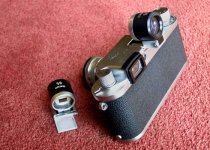jcb4718
Well-known
I wear glasses so using a Barnak was a problem. I came up with a couple of solutions (see attachment). Firstly I bought a old (film) SLR dioptre (which are readily available on Ebay). The frame that clips on to the camera is plastic so I cut off the sides using a Stanley knife, leaving just a lip at the top. I removed the Leica eyepiece and substituted the dioptre, securing it with Blu Tak. You laugh, but it works! I also bought a couple of the Canon viewfinders mentioned above. In my first attempt, I removed the pin and secured it to a cut-and-filed strip of Aluminium. I used screws so I needed to tap some screw holes into the bottom of the viewfinder. The thickness of the Aluminium enabled it to be securely slipped into the hot shoe. I obtained some old dioptre lenses. They are round (18.5mm OD) and were designed to be housed in 'universal' (film) SLR clip on eyepieces. By fantastic chance these can be fitted into the front of the Canon eyepieces, you just have to unscrew the front, insert the lens and screw the front back. I adjusted the height of the viewfinder using washers as shim. I adjusted the view to be correct at about 10 feet. in my second attempt the 85mm viewfinder) I obtained an old (1950's) Voigtlander clip on accessory shoe, removed the clip on bit, and attached the shoe to another cut-and-file Aluminium strip. In this case I kept the pin. I bored a very shallow hole in the shoe (into which the pin 'fitted') to obtain the best (10 foot) parallax. The second arrangement is MUCH easier to assemble. The viewfinders were not identical although they looked identical: in the first case I needed a little Blu Tak to secure the dioptre; in the second case it only just fitted and no Blu Tak was needed. One advantage of using the Aluminium strip is that it places the viewfinder behind the rear of the camera and so there is more room for one's nose! I had to figure out a way to attach dioptre lenses to a viewfinder because they do not provide enough eye relief when I wear my glasses. The Leica viewfinder is good but I can see no easy way to attach a dioptre correction lens.
Attachments
Last edited:


